|
Report from
the UK
Slowdown in UK tropical wood product imports
The import value of tropical wood and wood furniture into
the UK in the first ten months of last year was USD1.24B,
13% more than the same period last year. Following the
strongest start to the year in terms of UK import value
since before the 2008 financial crises, imports fell sharply
between July and October (Chart 1).
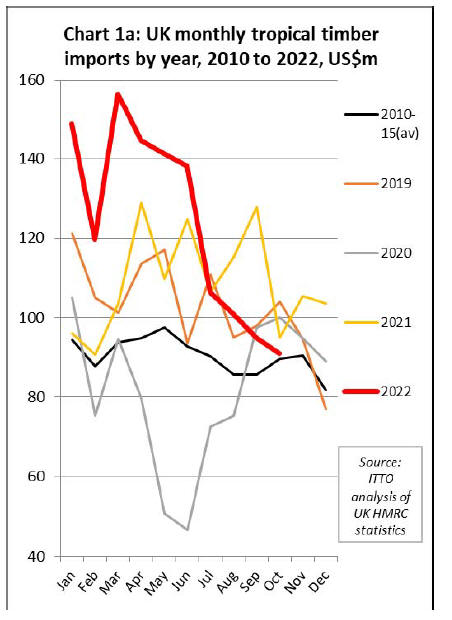
The trend looks different in quantity terms (Chart 1b).
Import quantity of tropical wood and wood furniture into
the UK in the first ten months of 2022 was 398,000
tonnes, 2% less than the same period last year.
In quantity terms, imports were at around the pre-covid
level in the first half of 2022 but fell to well below that
level between July and October. This suggests that price
inflation was the major factor behind relatively high UK
import value last year, driven both by historically high
material and freight prices and extreme weakness of
sterling against the US dollar.
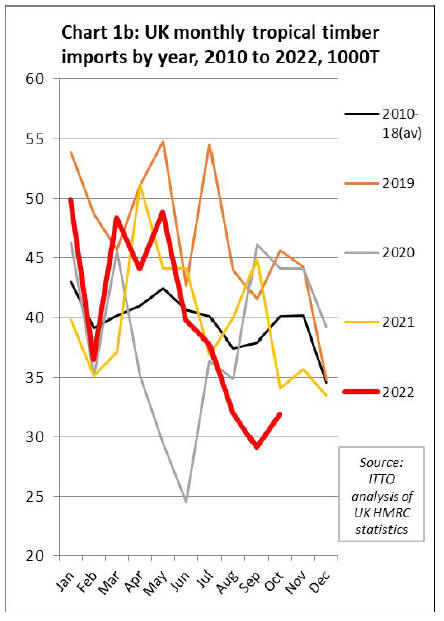
UK economy expected to be worst performing
amongst G7 next year
According to UK government figures published on 22
December, the economy contracted by more than first
estimated in the third quarter of last year. GDP fell by a
revised 0.3% against the 0.2% decline initially estimated
from July to September, the Office for National Statistics
(ONS) said. The manufacturing and construction sectors
performed worse than expected. Manufacturing activity
contracted 2.8%, worse than the 2.3% contraction
previously announced, while construction activity actually
shrank 0.2% compared to earlier estimated growth of
0.6%.
According to ONS, household incomes continued to fall
during the third quarter of 2022, though the rate of decline
slowed compared to the first two quarters of the year, and
household spending fell for the first time since the final
spring lockdown of 2021. The level of households'
disposable income fell by 0.5% in the quarter, the fourth
consecutive drop.
Household spending fell by a revised 1.1% in the quarter
as declines in tourism, transport, household goods and
services, and food and drink spending were seen.
A slowing in real consumption expenditure in the UK was
seen during 2022 including in restaurants and hotels, and
recreation and culture as a result of that reduced
disposable income and a cost of living crisis, fuelled by
high inflation. The UK government blamed the
disappointing figures on high inflation caused by the
invasion of Ukraine.
More positively, ONS recorded GDP growth of 0.5% in
October, a stronger performance than expected by
economists.
However this was explained by the number of working
days returning to normal rather than any real surge in
output.
The UK economy is still expected to be confirmed as
having entered a recession at the end of 2022 as the fourth
quarter as a whole is forecast to have experienced negative
growth.
The Confederation of British Industry (CBI) has also
forecast that the economy will contract 0.4% next year.
The UK is expected to be the worst performing than any of
the other G7 countries that form the group of the world's
largest industrialised democracies, according to forecasts
from the Organisation for Economic Cooperation and
Development (OECD).
Construction activity slows sharply in December
Overall, the UK construction sector was performing quite
well in the year to November. According to comments by
Timber Development UK, the UK trade association, new
house construction performed well. Housing completions
in the third quarter of 2022 were at the highest level since
2007. However, there was mounting uncertainty towards
the end of last year about future prospects in the
residential construction sector because of rising interest
rates.
While new residential construction was still strong in
2022, activity in the renovation and refurbishment sector -
which is particularly important for the hardwood sector -
was slowing from the heights achieved during and
immediately following the pandemic when a lot of money
was invested in home improvement. This sector is
expected now to slow much further, possibly by as much
as 10% in 2023.
The latest data from the S&P Global/CIPS UK
Construction Purchasing Managers’ Index (PMI) – which
measures month-on-month changes in total industry
activity - mirrors these trends. Overall UK construction
activity was growing between September and October last
year - driven mainly by the new residential sector - but
then activity recorded the fastest rate of decline since May
2020 in December.
Also in that month, sentiment amongst construction firms
towards activity in the year ahead dipped into negative
territory for only the sixth time on record, reflecting fears
around the near-term economic outlook. Pessimistic
expectations were reflected in the first round of job
shedding in the UK construction sector since January
2021.
At 48.8 in December, down from 50.4 in November, the
headline Construction PMI registered below the 50.0 mark
to signal the first contraction in construction sector output
since last August. Commercial construction activity
continued to rise in the final month of the year, but only
marginally, and this growth was outweighed by
contractions across the residential and civil engineering
sectors.
December PMI data also highlighted a reduction in new
orders placed with UK constructors, following a modest
uplift in November. According to survey respondents, the
fall was driven by weak client demand, linked in turn to
higher prices. Construction firms pared back on their
purchasing in December for the first time in three month,
reportedly due to lower workloads. Notably, the rate of
reduction was the steepest for over two-and-a-half years.
Imports of tropical wooden furniture much lower in third quarter
The UK imported US$647 million of tropical wood
furniture products in the first ten months of 2022, which is
3% more than the same period in 2021. In quantity terms,
wood furniture imports were 133,000 tonnes during the ten
month period, 9% less than the same period the previous
year. This indicates that the rise in value was driven more
by price inflation than strong demand. Imports between
June and October 2022 were much lower than the same
period in 2021.
In the first ten months of 2022 compared to the previous
year, UK import value of wood furniture increased 8%
from Vietnam to US$323 million, 15% from India to
US$72 million, 1% from Indonesia to US$63 million, and
30% from Thailand to US$19 million. Import value of
US$111 million from Malaysia was 1% less than the
previous year, while import value of US$49 million from
Singapore was 25% down compared to 2021. (Chart 2).
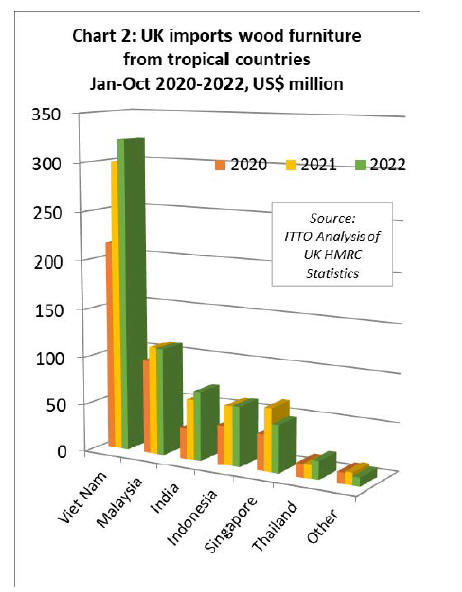
Import quanitity of tropical wood products flat overall in 2022
Total UK import value of all tropical wood products in
Chapter 44 of the Harmonised System (HS) of product
codes was US$595 million between January and October
last year, 27% more than the same period in 2021.
However in quantity terms imports increased just 1% to
265,000 tonnes during the period.
Compared to the first ten months of 2021, UK import
value of tropical joinery products increased 31% to
US$243 million, import value of tropical sawnwood
increased 53% to US$108 million, and import value of
tropical mouldings/decking increased 39% to US$29
million. Import value of tropical plywood was unchanged
at US$147 million (Chart 3).
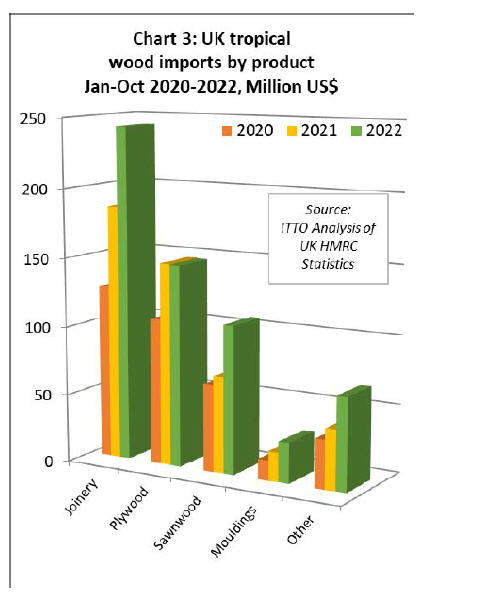
Slowing pace of imports of wood doors from Indonesia
The pace of increase in UK import value of tropical
joinery products slowed sharply between July and October
2022. Import value from Indonesia, by far the largest
supplier of tropical joinery products to the UK (in this case
mainly doors), was at US$126 million still up 7% year-onyear
in the first ten months of 2022 (Chart 4).
In quantity terms, UK joinery imports from Indonesia
were 40,650 tonnes in the first ten months of last year, 6%
less than the same period in 2021.
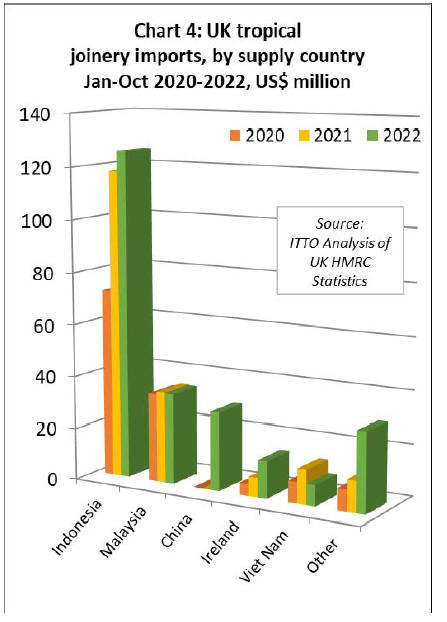
UK imports of joinery products from Malaysia and
Vietnam (mainly laminated products for kitchen and
window applications) were slow from the start of last year.
Import value from Malaysia was US$35 million between
January and October last year, 1% less than the same
period in 2021. In quantity terms, imports from Malaysia
were 8,900 tonnes, 28% less than the same period in 2021.
Joinery imports from Vietnam of 2200 tonnes valued at
USD8 million were respectively 40% and 39% less than
the same period in 2021.
UK imports of Chinese tropical joinery products, nearly all
comprising doors, were 11,900 tonnes with value of
USD30 million in the first ten months of 2022, up from
negligible levels in previous years. The recorded rise was
due to introduction from 1st January 2022 of new product
codes which identify wood doors and windows
manufactured using a wider range of tropical wood species
in UK and EU trade statistics.
This may also explain the apparent rise in UK imports of
tropical joinery products from Ireland which were 1,400
tonnes with value of US$14 million in the first ten months
of 2022, respectively 53% and 91% more than the same
period in 2021.
Tropical hardwood plywood imports decline from all leading sources
In the first ten months of 2022, the UK imported 177,600
cu.m of tropical hardwood plywood, 29% less than the
same period the previous year, with significant decline in
imports from all the main traditional supply sources
including Indonesia, Malaysia, and China (Chart 5).
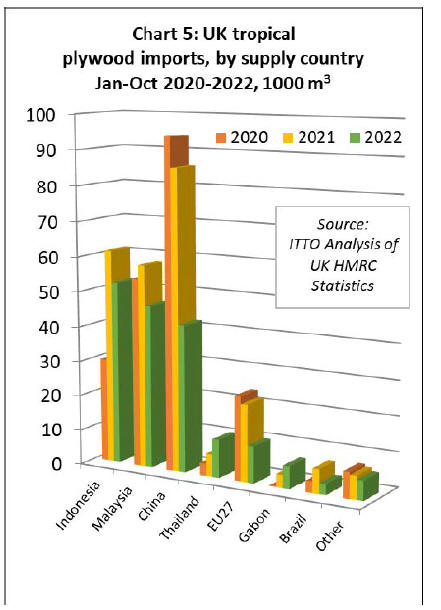
After a strong start to 2022, UK tropical hardwood
plywood imports from Indonesia and Malaysia slowed
dramatically between June and October last year. After the
first ten months, imports from Indonesia were, at 52,400
cu.m, 15% less than the same period the previous year.
The UK imported 46,500 cu.m of plywood from Malaysia
in the first ten months of 2022, 20% less than the same
period the previous year.
The UK imported 42,100 cu.m of tropical hardwood
plywood from China in the first ten months of 2022, 51%
less than the same period in 2021. Probably the biggest
shift in the UK hardwood plywood trade in the last two
years has been a rapid decline in imports of Chinese
products faced with tropical hardwoods in favour of
Chinese products faced with temperate hardwoods.
Chinese temperate hardwood plywood has been the largest
beneficiary of UK sanctions against all trade in Russian
wood products since the start of the Ukraine conflict.
Meanwhile, the combined effects of Brexit, supply
shortages and rising energy and other material costs on the
European continent is impacting on UK imports of tropical
hardwood plywood from EU countries which were just
10,400 cu.m in the first ten months of 2022 compared to
over 20,000 cu.m during the same period in the previous
two years.
Bouyant UK imports of tropical sawnwood during 2022
Unlike tropical hardwood plywood, UK imports of
tropical sawnwood were buoyant last year. Total UK
imports of tropical sawnwood were 93,800 cu.m in the
first ten months of 2022, 34% more than the same period
in 2021. In addition to making gains overall, there were
some significant changes in the countries supplying
tropical sawnwood to the UK last year (Chart 6).
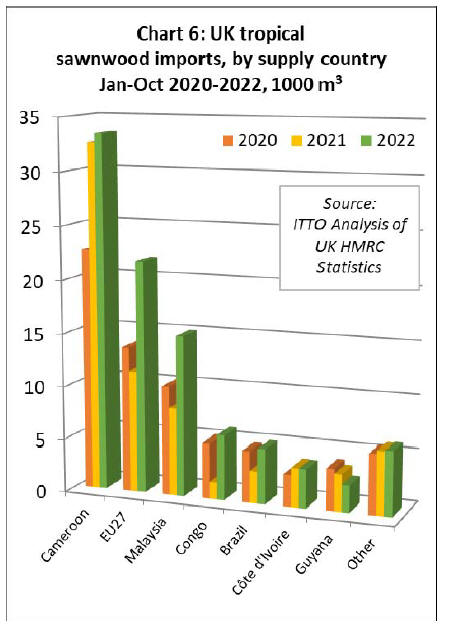
UK imports of tropical sawnwood from Cameroon were
33,400 cu.m in the first ten months of 2022, 3% more than
the relatively high level in the same period in 2021. UK
imports of tropical sawnwood from the Republic of Congo
recovered lost ground last year, with imports of 6,000
cu.m in the first ten months, a 274% gain compared to the
same period the previous year.
UK imports from Côte d'Ivoire were 3,700 cu.m in the
first ten months of last year, a 1% decline compared to the
same period in 2021.
UK imports of sawnwood from Malaysia, which had fallen
to little more than a trickle in previous years, were 15,000
cu.m in the first ten months of 2022, 83% more than in the
same period in 2021. UK imports of tropical sawnwood
from Brazil were 5,200 cu.m in the first ten months of last
year, 71% more than the same period in 2021.
Indirect UK imports of tropical sawnwood via the EU also
recovered ground last year despite the Brexit disruption,
increasing 91% to 22,000 cu.m in the first ten months of
2022.
UK imports of tropical hardwood mouldings/decking were
high in the first ten months of 2022, at 9,900 tonnes, 28%
more than the same period in 2021. This commodity group
has benefited in the UK market from shortages of nontropical
products, particularly since the start of the war in
Ukraine and sanctions on Russian decking products that
directly compete with tropical decking. Imports of 3,800
tonnes from Indonesia were 40% more than the same
period in 2021.
Imports of 2,500 tonnes from Malaysia were 37% up on
the same period in 2021. However mouldings/decking
imports from Brazil of 1,650 tonnes were 8% less than the
same period in 2021. (Chart 7).
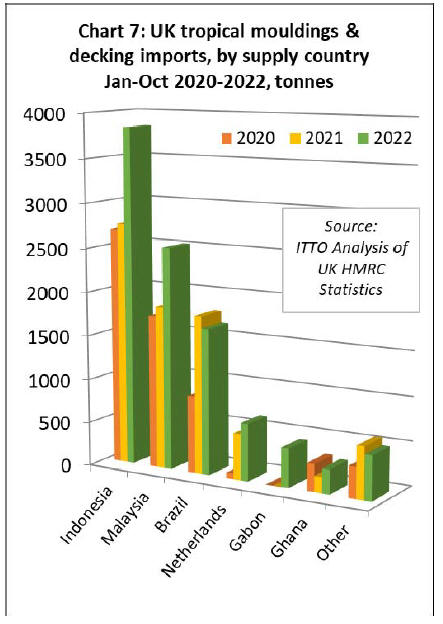
Tropical hardwood imports expected to remain low
over winter months
UK hardwood contacts suggest that imports from tropical
countries are likely to remain low over the winter months.
Conditions on the demand side are uncertain and, in the
case of sawnwood and decking products, importers are
now carrying a lot of expensive stock following the high
levels of import in the first half of the year.
The supply side situation is also challenging, particularly
as the UK is not such an attractive market as in the past
with buyers elsewhere in the world generally willing to
pay more and to be more flexible with regard to species
and grade.
For African wood, UK importers report very difficult
supply conditions, with many logistical challenges,
problems of cash flow, and high energy costs. Lack of kiln
drying capacity in the UK and a preference for certified
products makes it even more challenging for UK importers
to place contracts in Africa.
The UK market for tropical sawnwood is very focused on
sapele, for which demand was still reported to be quite
good in the final quarter last year. However, as one
importer noted, “there is lot of sapele about in the UK at
the moment”. Demand for sapele benefited in the early
months of last year from difficult supply conditions for
accoya and other modified temperate woods, but supply of
those alternatives is now improving again.
For Southeast Asian hardwoods, decline in global demand
and the rapid falloff in freight rates that occurred in the
second half of last year has helped ease the supply
situation, and there are more opportunities to buy product
at competitive prices, but UK buyers are wary given
current market uncertainty and existing high stock levels.
|